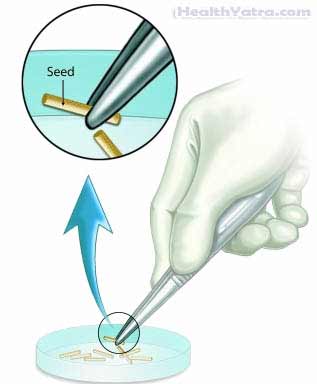تعريف
Radiation therapy is a treatment of cancer and other diseases. It uses high-energy particles to damage the genetic code (DNA) in the cancer cells. This makes the cells unable to grow or divide.
There are two main types of radiation therapy:
- External—radiation is delivered by a machine that shoots particles at the cells from outside the body
- Internal—radioactive materials are placed in the body near the cancer cells (also called implant radiation or brachytherapy)
In certain cases, your doctor may recommend a combination of these. Radiation is often used with other types of treatment, such as surgery, chemotherapy, and immunotherapy (stimulates the immune system to fight infection).
This fact sheet will focus on internal radiation therapy.
أسباب هذا الإجراء
- Control the growth or spread of cancer
- Attempt to cure cancer
- Reduce pain or other symptoms caused by cancer (called palliative radiation)
Radiation therapy is commonly used to treat solid tumors such as prostate cancer, breast cancer, and head and neck cancers.
المضاعفات المحتملة
Internal radiation can cause side effects as the radiation damages your own healthy cells as well as the cancer cells. The side effects will vary, depending on the type and location of treatment. Common side effects of radiation include, but are not limited, to:
- تعب
- Skin changes (redness, irritation)
- Reduced white blood cell count
- تساقط الشعر
- Nausea, vomiting, or diarrhea
- Appetite loss
Discuss the specific side effects that you may have with your doctor.
تشمل العوامل التي قد تزيد من خطر حدوث مضاعفات ما يلي:
- Previous radiation therapy
- A personal history of lupus, scleroderma, or dermatomyositis
A woman who is pregnant or could be pregnant should avoid exposure to radiation. It could harm a developing fetus.
ما يمكن توقعه
قبل الإجراء
التخدير
You may need local anesthesia, which will numb a small area, or general anesthesia, which keeps you asleep during the procedure.
وصف الإجراء
The radiation source will be placed inside your body on or near the affected area. This provides higher doses of radiation in a shorter time. The radioactive sources (such as cesium, iridium, palladium, or iodine) are in the form of wires, seeds, or rods. This treatment is mostly used for cancers of the head and neck, breast, uterus, thyroid,cervix, and prostate. The two main types of internal radiation are:
- Interstitial radiation—Rods, ribbons, or wires placed inside the affected tissue on a short-term or permanent basis
- Intracavitary radiation—A container of radioactive material placed inside a body cavity, such as the uterus, vagina, or windpipe (always temporary)

كم من الوقت سيستغرق ؟
This depends on the type of cancer treated and the method of internal radiation used.
هل سيكون هناك ألم؟
Anesthesia prevents pain during the procedure. You may be sore when recovering from the procedure depending on where the radioactive material was placed.
متوسط الإقامة في المستشفى
You will stay in the hospital until the implant is removed, or in the case of a permanent implant, when the radioactivity has decreased. Doctors usually remove high-dosage implants within a matter of minutes. Low-dosage implants may stay in for a few days. Permanent implants lose their radioactivity within a few days.
رعاية ما بعد العملية
تأكد من اتباع تعليمات طبيبك.
You will return to a hospital room while the implant is in place. While the radiation is implanted, you will follow these precautions to prevent transmitting radiation to others:
- Limited visitation: Many hospitals do not allow children under 18 years old or pregnant women to visit a patient having implant radiation. They may visit once the implant is removed. If visitors are allowed, they will need to sit at least six feet from the bed. Visits will be limited to a short time (10-30 minutes). Staff may place a shield beside the bed to protect visitors and staff from radiation exposure.
- Limited contact with the staff: The staff will be available to you at all times. They may speak to you from the doorway. They may also come and go very quickly to avoid excessive radiation exposure.
During treatment, your doctor will want to see you at least once a week. You may have routine blood tests to check for the effects of radiation on your blood cells.
After treatment is completed, you will have regular visits to monitor healing and to make sure the treatment affected the disease as planned. Follow-up care will vary for each person. Care may include further testing, medicine, or rehabilitative treatment.
Tell your doctor if you experience side effects. Many side effects can be controlled with medicine or diet. Your doctor may change or delay the course of your treatment if the side effects are too much. Most side effects will gradually go away after treatment.
استدعاء الطبيب
After arriving home, contact your doctor if any of the following occur
- علامات الإصابة, بما في ذلك حمى وقشعريرة
- Diarrhea or loss of appetite
- فقدان الوزن غير المبرر
- Frequent urination, particularly if it is associated with pain or burning sensation
- New or unusual swelling or lumps
- Nausea and/or vomiting that you cannot control with the medicines you were given
- Pain that does not go away
- Unusual changes in skin, including bruises, rashes, discharge, or bleeding
- السعال، ضيق التنفس، أو ألم في الصدر
- Any other symptom your nurse or doctor told you to look for
- Any new symptoms
في حالة الطوارئ ، اتصل على المساعدة الطبية على الفور.
